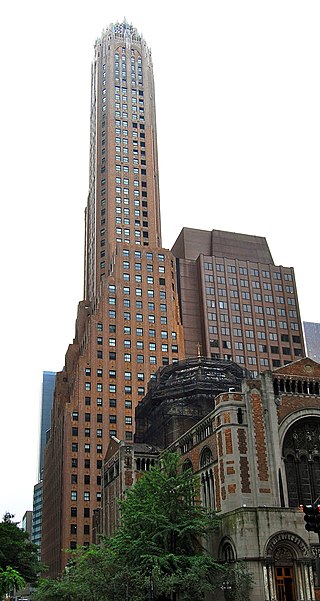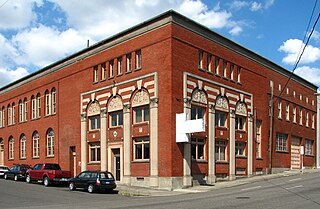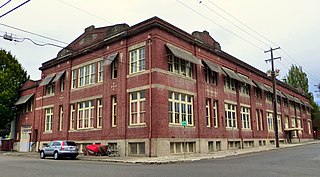
40 Wall Street is a 927-foot-tall (283 m) neo-Gothic skyscraper on Wall Street between Nassau and William streets in the Financial District of Manhattan in New York City, New York, U.S. Erected in 1929–1930 as the headquarters of the Manhattan Company, the building was designed by H. Craig Severance with Yasuo Matsui and Shreve & Lamb. The building is a New York City designated landmark and is listed on the National Register of Historic Places (NRHP); it is also a contributing property to the Wall Street Historic District, an NRHP district.

Capital Group is an American financial services company. It ranks among the world's oldest and largest investment management organizations, with over $2.6 trillion in assets under management. Founded in Los Angeles, California in 1931, it is privately held and has offices around the globe in the Americas, Asia, Australia and Europe.

The General Electric Building, also known as 570 Lexington Avenue, is a skyscraper at the southwestern corner of Lexington Avenue and 51st Street in Midtown Manhattan, New York City. The building, designed by Cross & Cross and completed in 1931, was known as the RCA Victor Building during its construction. The General Electric Building is sometimes known by its address to avoid confusion with 30 Rockefeller Plaza, which was once known as the GE Building.

The Brooklyn Trust Company was a bank in New York City. Chartered in 1866, the Brooklyn Trust Company originally offered trust management and estate management services but also functioned as a commercial bank. The Brooklyn Trust Company acquired over a dozen smaller banks throughout its existence, merging with the Manufacturers Trust Company in 1950.

The Marbridge Building is an office building at 1328 Broadway, on the east side of Sixth Avenue between 34th and 35th Streets in Herald Square, Manhattan, New York City. It opened in 1909, an 11-story structure, utilized in part by men's clothier Rogers Peet. Until October 1910 it stood opposite the Alpine apartment house, which was at the northeast corner of Broadway and 33rd Street. The Alpine and old stores between 33rd and 34th Streets were demolished to make room for the $5,000,000 Hotel McAlpin near the end of 1910. On the other side of Broadway were located the Macy's Herald Square and Saks Incorporated stores, with the Gimbels store just below.
The Segal Lock and Hardware Company of Manhattan, New York, was a leading manufacturer of hardware merchandise and razor blades in the 1920s and 1930s. Established in Connecticut and Manhattan, the firm relocated to Brooklyn, New York, in the mid-1920s. The Segal Safety Razor Corporation was a subsidiary of the Segal Lock and Hardware Company. The business was at first known as the Burglar-Proof Lock Company.

Kent Automatic Garages were popular in several metropolitan areas in the U.S. from the late 1920s through the early 1960s. They enabled customers to park their cars for an hour or longer with a standard rate of $.50 per hour for the first two hours, and $.05 for each additional hour or fraction thereof, for a twenty-four-hour period. One of the first Kent Automatic Garages was at 44th Street, just east of 3rd Avenue, and another is a block west of Columbus Circle.
Consolidated Indemnity and Insurance Company was a Hartford, Connecticut-based firm which became insolvent during the Great Depression. The corporation is important because it employed executives who were formerly directors of significant business concerns of New York City, in the early 1930s and before. Consolidated Indemnity and Insurance Company was organized in October 1928 with a capital of $2,500,000 and a surplus of $7,300,000. Among its fifteen directors were Saul Singer, vice-president of the New York Bank of the United States and C. Stanley Mitchell, president of the Central Mercantile Trust Company. Its president was John F. Gilchrist, chairman of the Tate Transit Commission. Gilchrist was a close personal and boyhood friend of Alfred E. Smith.
Deco Refreshments, Inc. was a restaurant chain in Buffalo, New York which operated thirty-nine restaurants in 1929. It was started in December 1926 with an initial capitalization of $150,000. This increased to $250,000 in February 1928. Deco Refreshments, Inc., it experienced major growth in the late 1920s and early 1930s. Its stock was popular and was included in the portfolio of the Niagara Share Corporation, which held 7,580 shares of Deco Refreshments, Inc., in February 1931.
Legnam Corporation operated 132 general merchandise stores in 38 of the United States prior to becoming insolvent in June 1932. It sold ladies' apparel. Owing to the financial crisis during the Great Depression, the chain store, formerly known as Mangel's, became unable to pay its debts. The company maintained offices at 1115 Broadway and 226 Main Street in Paterson, New Jersey.
American Yvette Company was a Chicago, Illinois based business that manufactured cosmetics and operated beauty shops. It thrived in the late 1920s and 1930s. The company ran hairdressing and beauty shops in thirty-seven leading department stores in thirty-four cities in the United States, in February 1929. It maintained exclusive rights to manufacture and sell Evera permanent wave machines in the United States and foreign countries. The firm is significant for being innovative during the Great Depression, especially in maintaining efficiency of production.
The Associated Telephone Utilities Company was a Wisconsin-based power company that went bankrupt in 1933, during the Great Depression. Prior to the Depression, the utility was a prominent player in the electrical power business in the Midwestern United States. An appeal by receivers appointed for the Associated Telephone Utilities Company was filed around April 1933, contesting the bankruptcy of the utility, and it was reorganized in 1934 as General Telephone. A chancellor in a court of chancery permitted the petition to be filed in United States District Court.
Zonite Products Corporation was a New York City based company formed in 1922. Headquartered in the Chrysler Building, it became a leader in the medical preparations' field starting in 1930. In February 1930, it purchased for $215,000 the New Brunswick manufacturing plant of Reichardt Cocoa & Chocolate Company. By April 1931, Zonite's subsidiaries became concentrated in a single production facility. These included Zonite, Forhan's toothpaste and antiseptic, Argyrol, and Larvex. Annette's Perfect Cleanser Company was acquired in March 1932.

Biflex Products Corporation was a Winnetka, Illinois based manufacturer of automobile bumpers. In July 1923 the company was listed as a co-conspirator with American Chain Company of New York City in an effort to restrain trade and restrict interstate commerce. A lawsuit in United States Federal Court sought to prevent American Chain Company from acquiring a monopoly in the sales of automobile bumpers. The effort to restrain trade began prior to January 1, 1920
Starrett Corporation, formerly known as Starrett Brothers, Inc. and Starrett Brothers and Eken, is a real estate development and construction firm known for having built the Empire State Building, Stuyvesant Town, Starrett City and Trump Tower in New York City.
Harrison Radiator Corporation was an early manufacturer of automotive radiators and heat exchangers for crewed spacecraft and guided missiles, as well as various cooling equipment for automotive, marine, industrial, nuclear, and aerospace applications, that became a division of General Motors in 1918. Today its business is a part of General Motors' Automotive Components Group, and is based in Lockport, Niagara County, New York.

The Yale Union Laundry Building, also known as the Yale Laundry Building, the City Linen Supply Co. Building, Perfect Fit Manufacturing and simply Yale Union (YU), in southeast Portland, Oregon, is a two-story commercial structure listed on the National Register of Historic Places. Built largely of brick in 1908, and embellished with Italian Revival and Egyptian Revival decorations, it was added to the register in 2007. Two-story additions in 1927 and 1929 changed the original building into an L-shaped structure that shares a party wall with a building to the east.

The Troy Laundry Building, located at 1025 Southeast Pine St. in Portland, Oregon, was designed by Ellis F. Lawrence in the early 1900s. It is considered a mixture of Colonial, Egyptian, and Renaissance Revival architecture. It is known for its large windows, tall brick walls, and decorative brickwork.

The Continental Bank and Trust Company of New York was a financial institution based in New York City, New York, United States. It was established in 1870 as the German-American Bank, which became the Continental Bank of New York. Originally in the Equitable Building at 120 Broadway, the bank was later headquartered at 50 Wall Street, 25 Broad Street, and starting in 1932 the Continental Bank Building It became known as the "brokers bank" for its collaboration with Wall Street brokers and investment banking interests. The institution was renamed the Continental Bank and Trust Company of New York around 1929, at which point it was involved in extending its business with acquisitions of commercial banking and fiduciary operations. Acquired banks included the Fidelity Trust Company in 1929, International Trust Company and Straus National Bank and Trust Company in 1931, and Industrial National Bank later that year. In 1947, the bank earned $804,000 in net profits. As of December 31, 1947, Continental had total resources of $202,000,000, and deposits of $188,000,000. It merged with the Chemical Bank and Trust Company in 1948.
Houdaille Industries was a diversified manufacturing company which produced automotive products, industrial products, machine tools, construction materials and contracting. The company had its beginnings in Buffalo, New York, in 1919, where the Houde Engineering Corporation manufactured shock absorbers that had been invented and patented in France by Maurice Houdaille (1880-1953). The company continued to grow with the automobile industry, and through diversification, until 1987 when it was forced to liquidate most of its assets to satisfy obligations to investors from a 1979 leveraged buy out.









